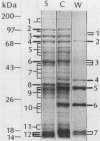Abstract
Most juvenile periodontitis patients respond to infection by Actinobacillus actinomycetemcomitans by producing serum antibodies. Specific antigens inducing the humoral immune response have not been identified, nor has the role of the resulting antibodies in disease progression been determined. Adsorbed and unadsorbed sera from juvenile periodontitis patients and normal subjects were analyzed by enzyme-linked immunosorbent assay and Western blots (immunoblots), using digested and undigested bacterial sonicates and French pressure cell fractions to determine the biochemical class, cross-reactivity, and cellular location of the antigens in different A. actinomycetemcomitans serotypes. Antigens detected by using high-titer sera included the following: (i) serotype-specific nonprotein material located on the cell surface, (ii) soluble-fraction proteins showing highly variable antibody binding, (iii) cross-reactive proteins, and (iv) a protein present in soluble and cell wall fractions and immunopositive for all sera tested. In addition, one apparently nonprotein component that was enriched in the cell wall fraction was observed. Sera with high immunoglobulin G titers to one, two, three, or none of the three A. actinomycetemcomitans serotypes were observed. There was a high degree of variation from one patient to another in the humoral immune response to serotype-specific and cross-reactive antigens. As demonstrated by whole-cell adsorption experiments, the serotype-specific surface antigen accounted for approximately 72 to 90% of the total antibody-binding activity for sera with titers greater than 100-fold above background, while cross-reactive antigen accounted for less than 28%. Antibody binding the whole-cell sonicate for high-titer sera was inhibited 90% by lipopolysaccharide from the same serotype, strongly suggesting that lipopolysaccharide is the immunodominant antigen class.
Full text
PDF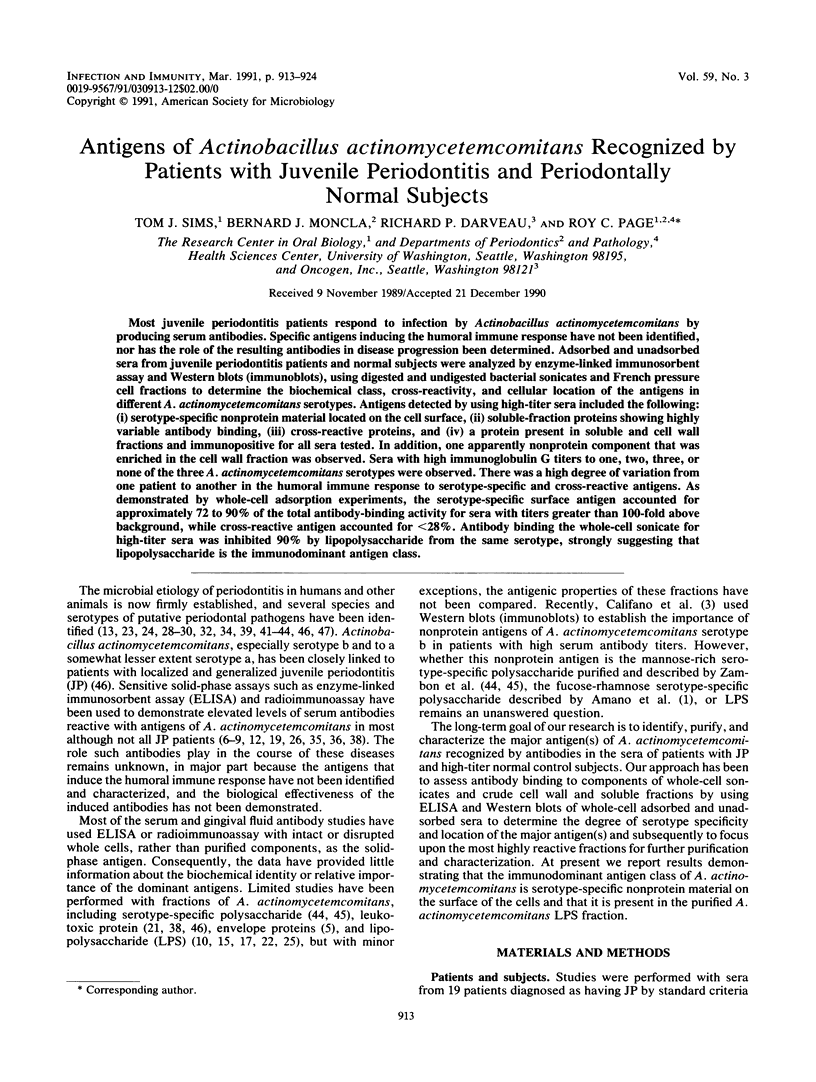
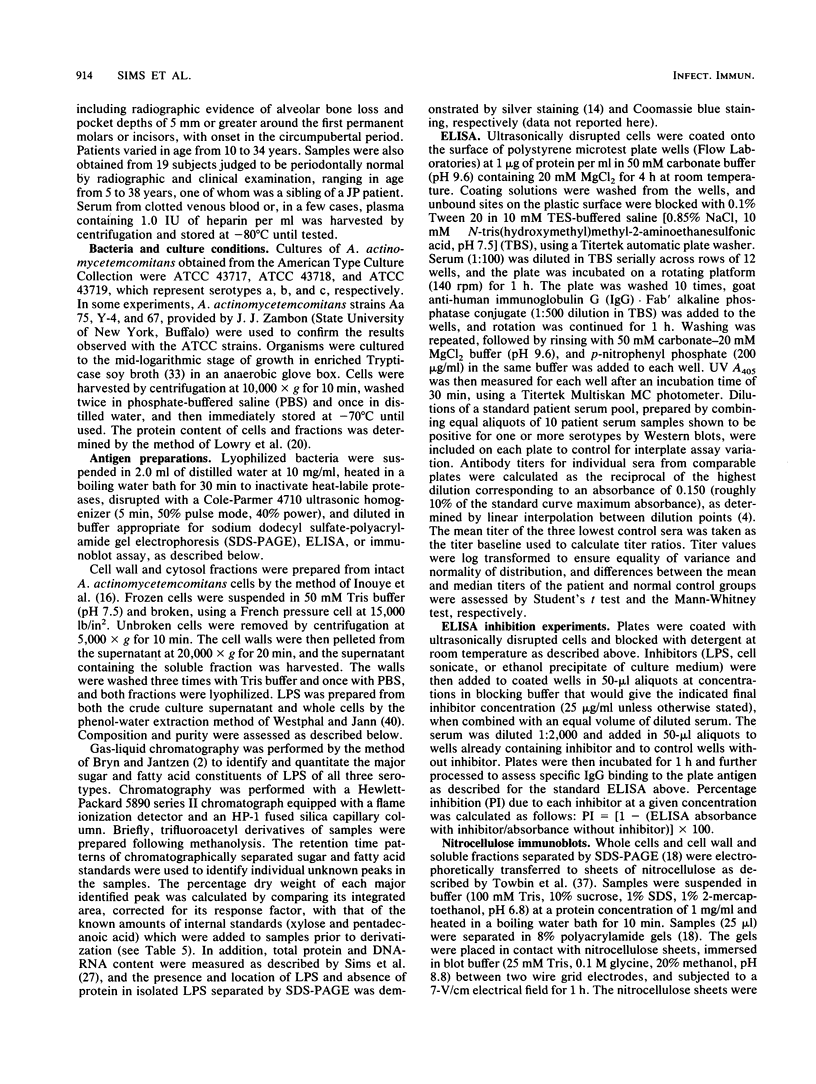
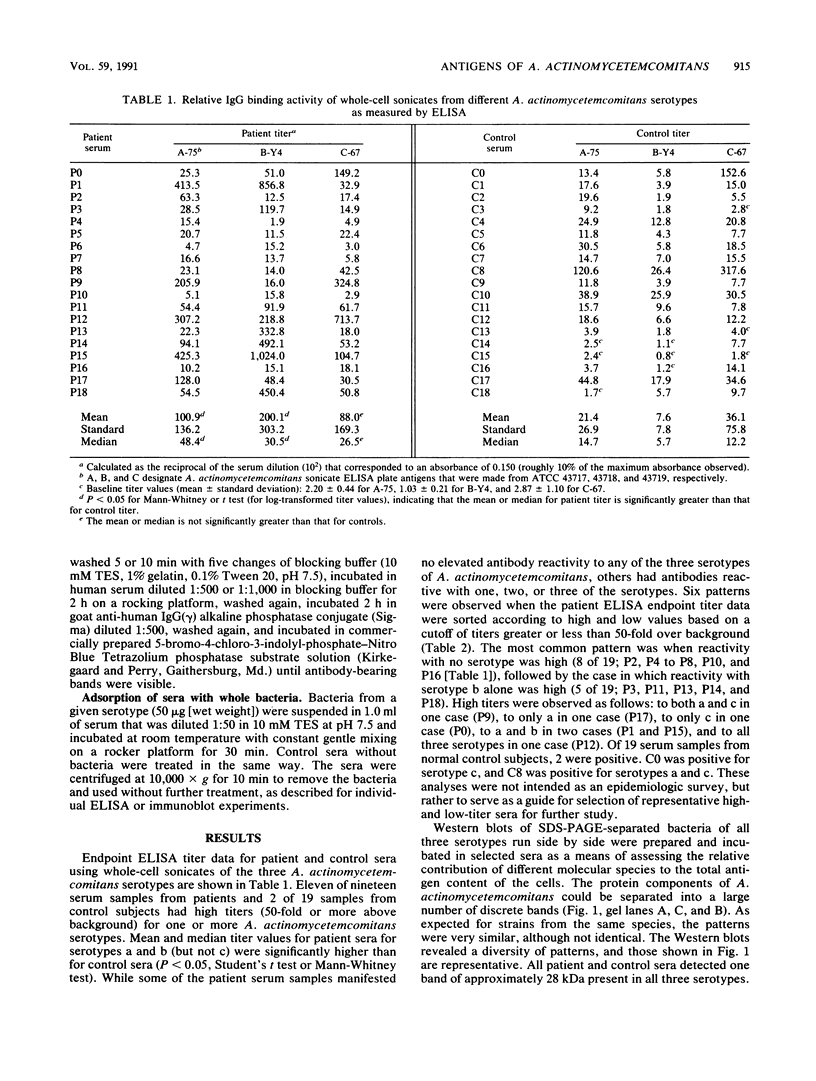
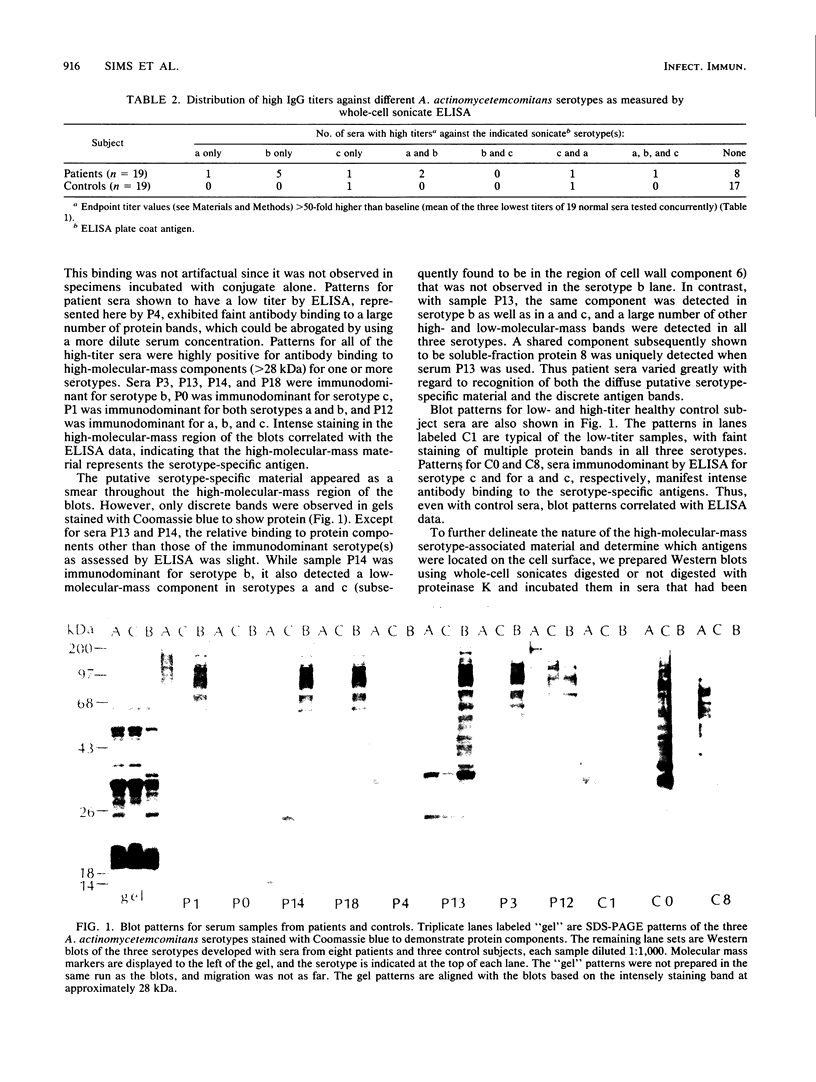
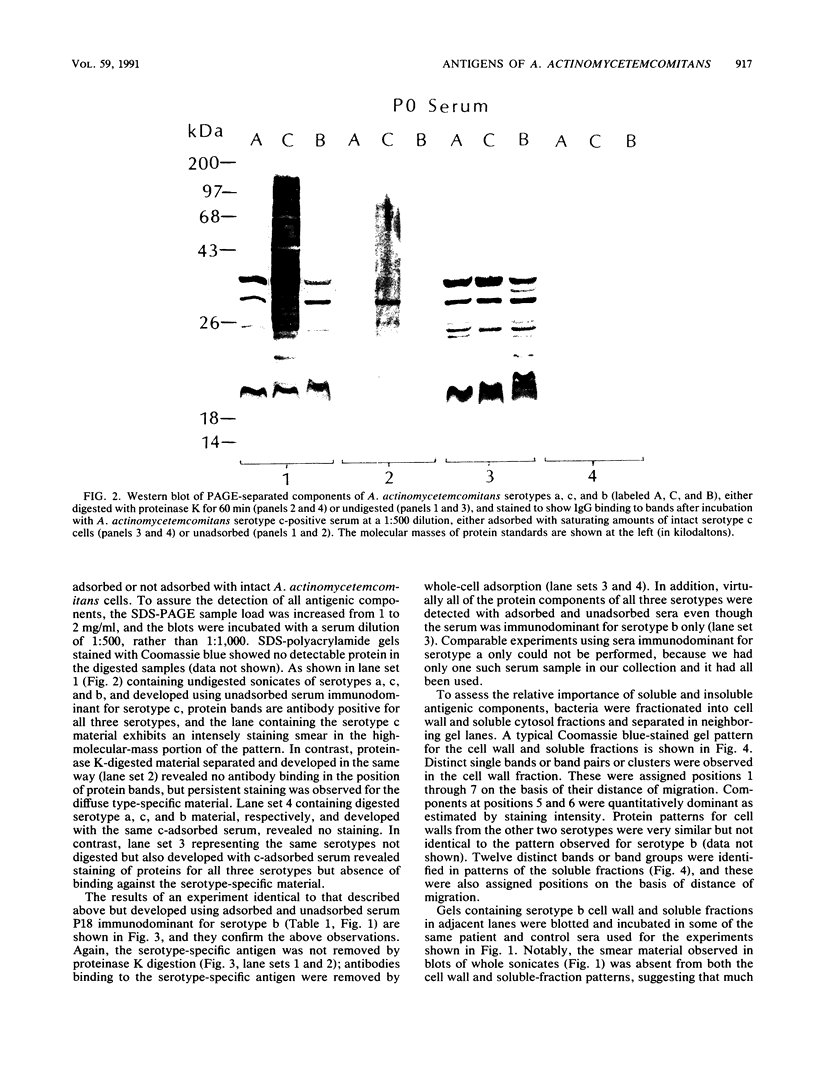
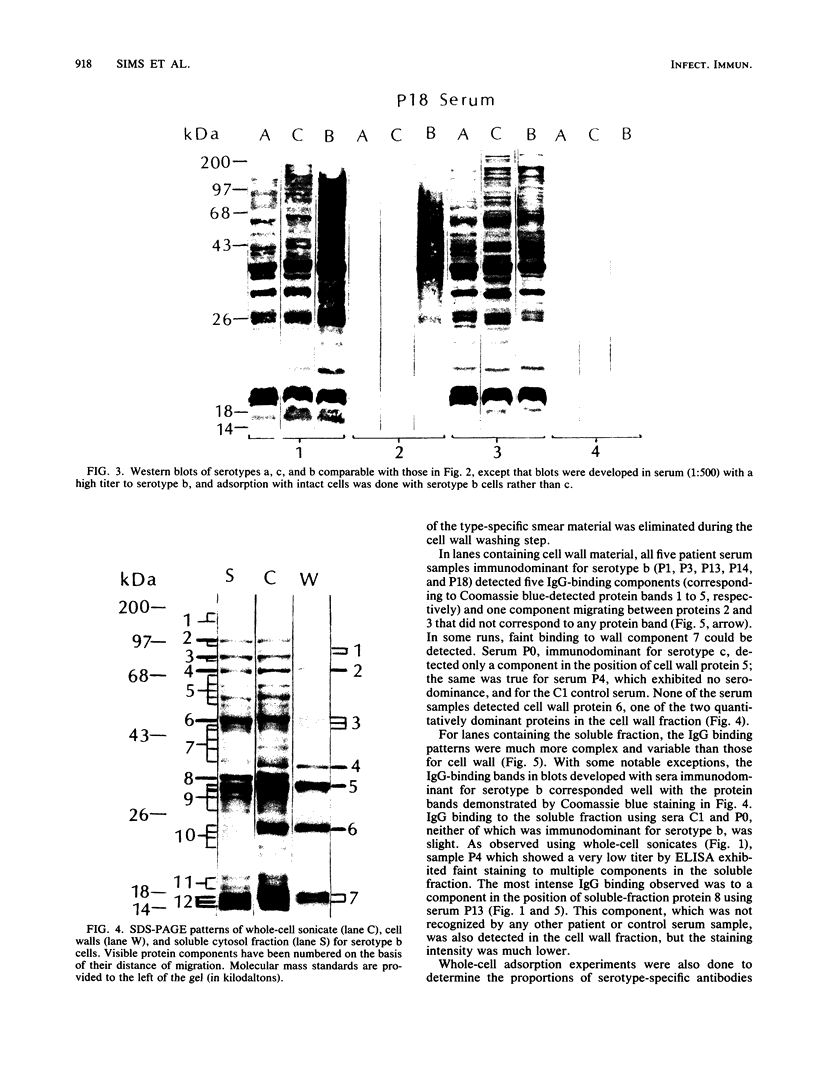
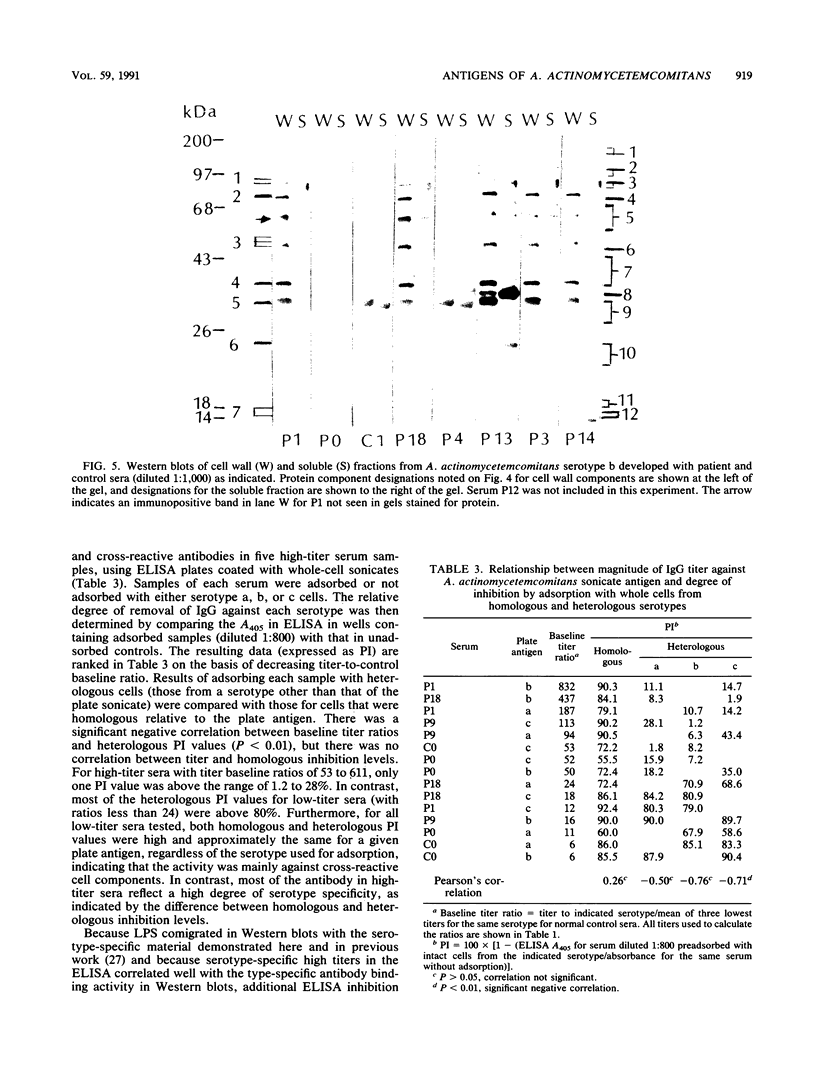
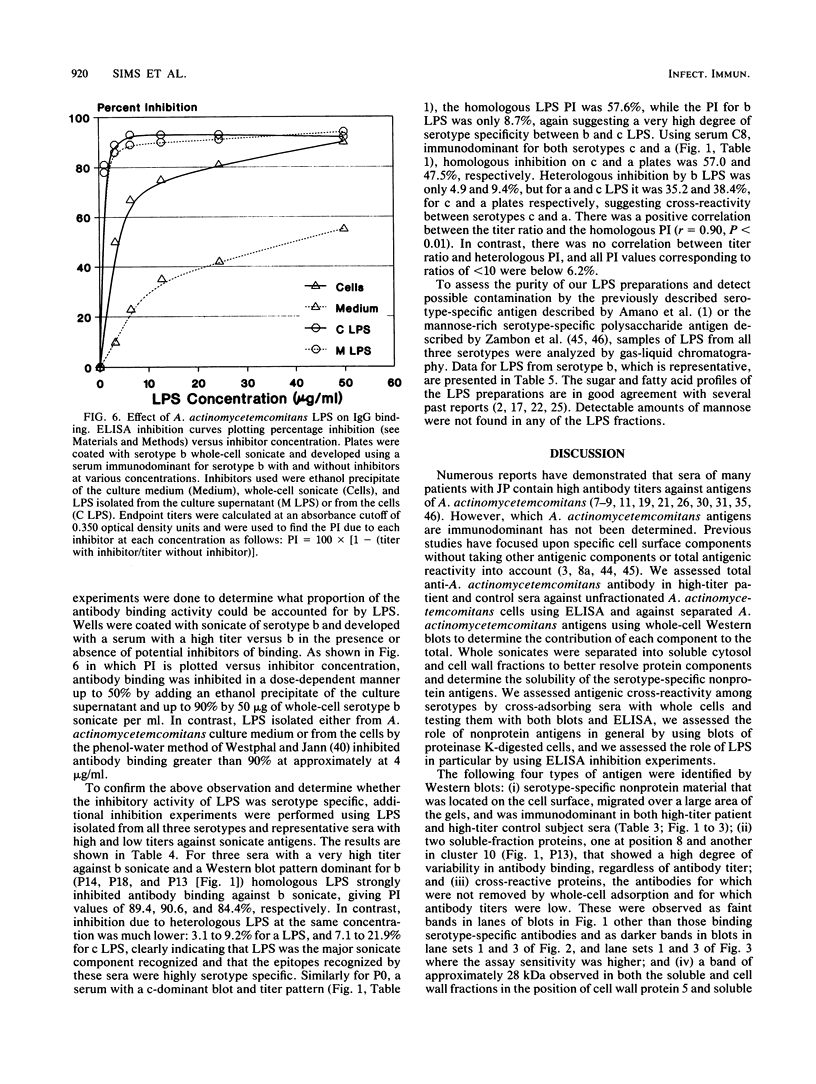
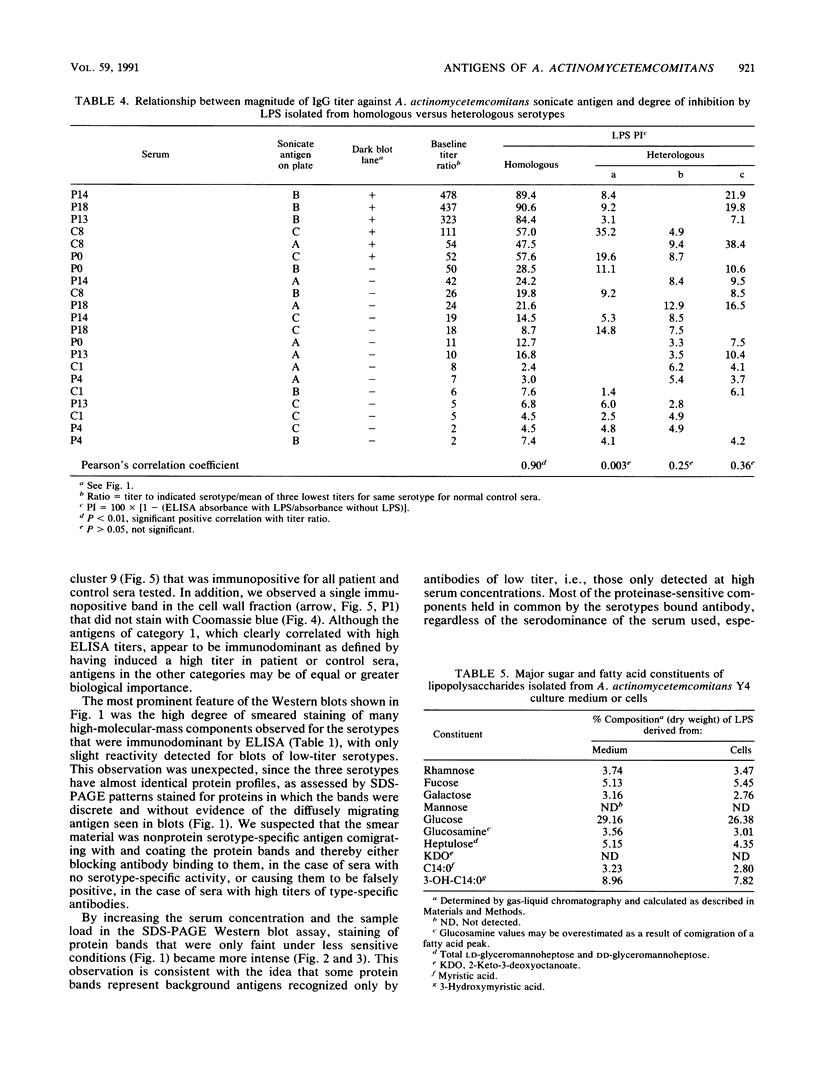
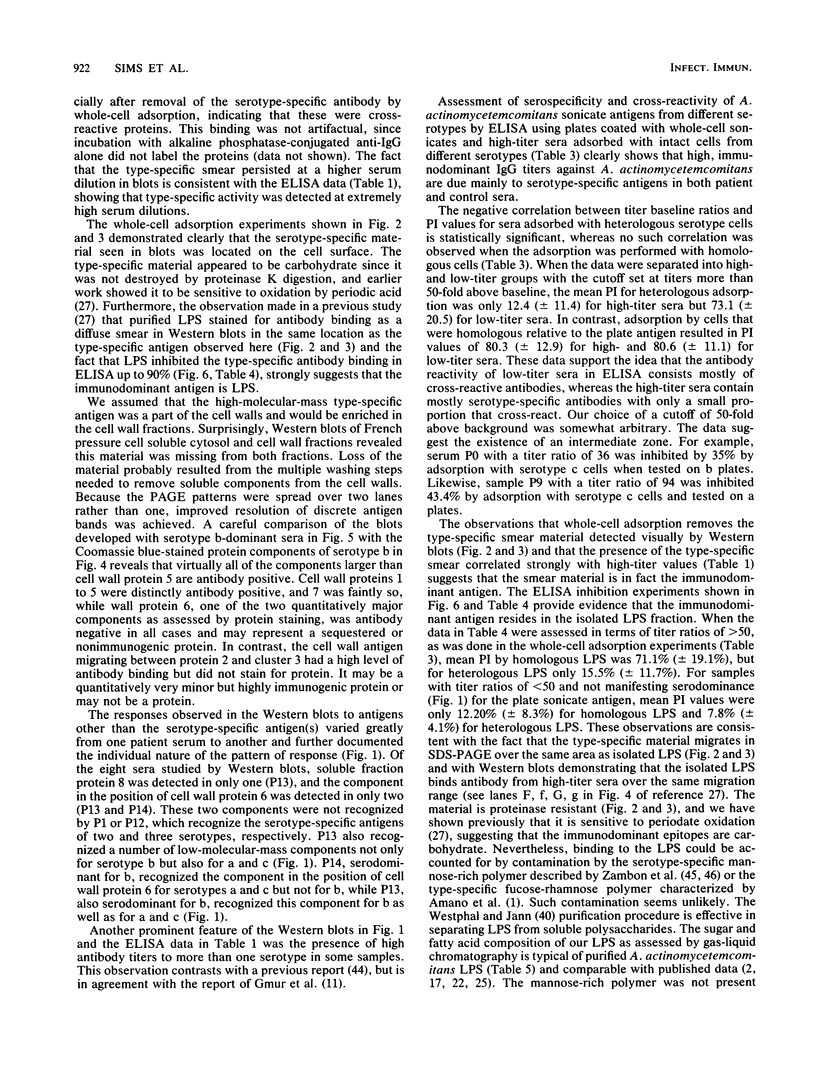
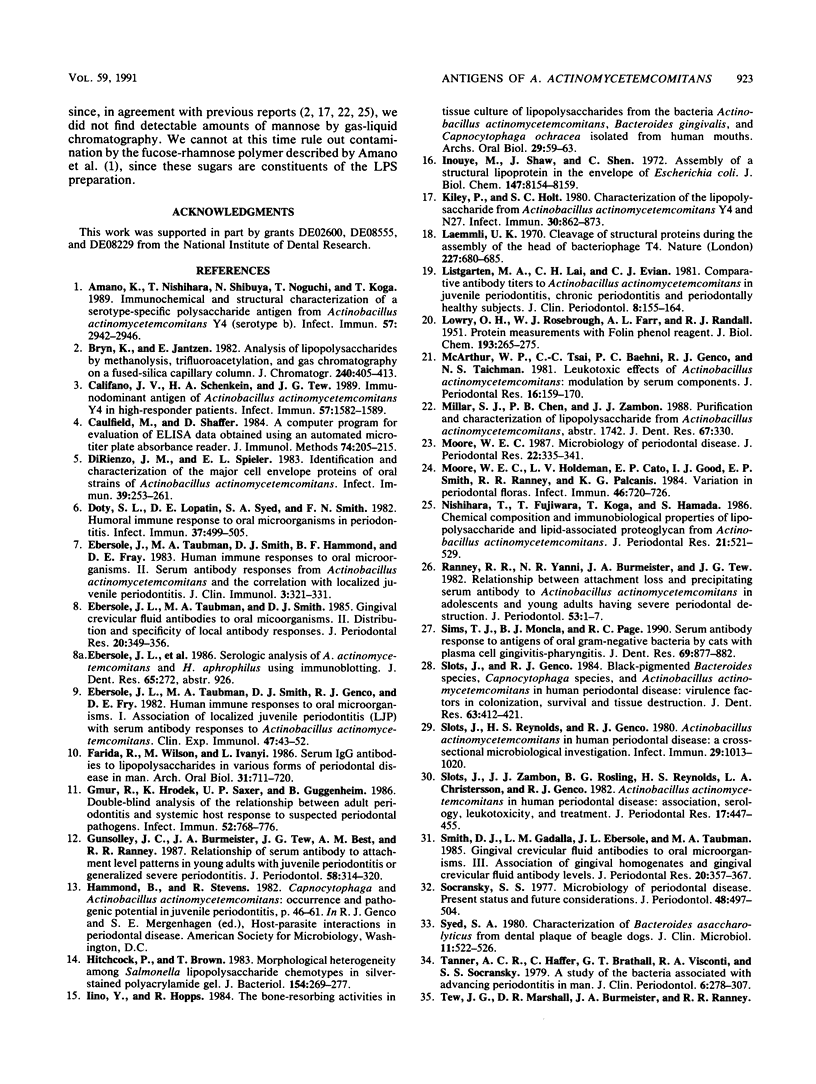
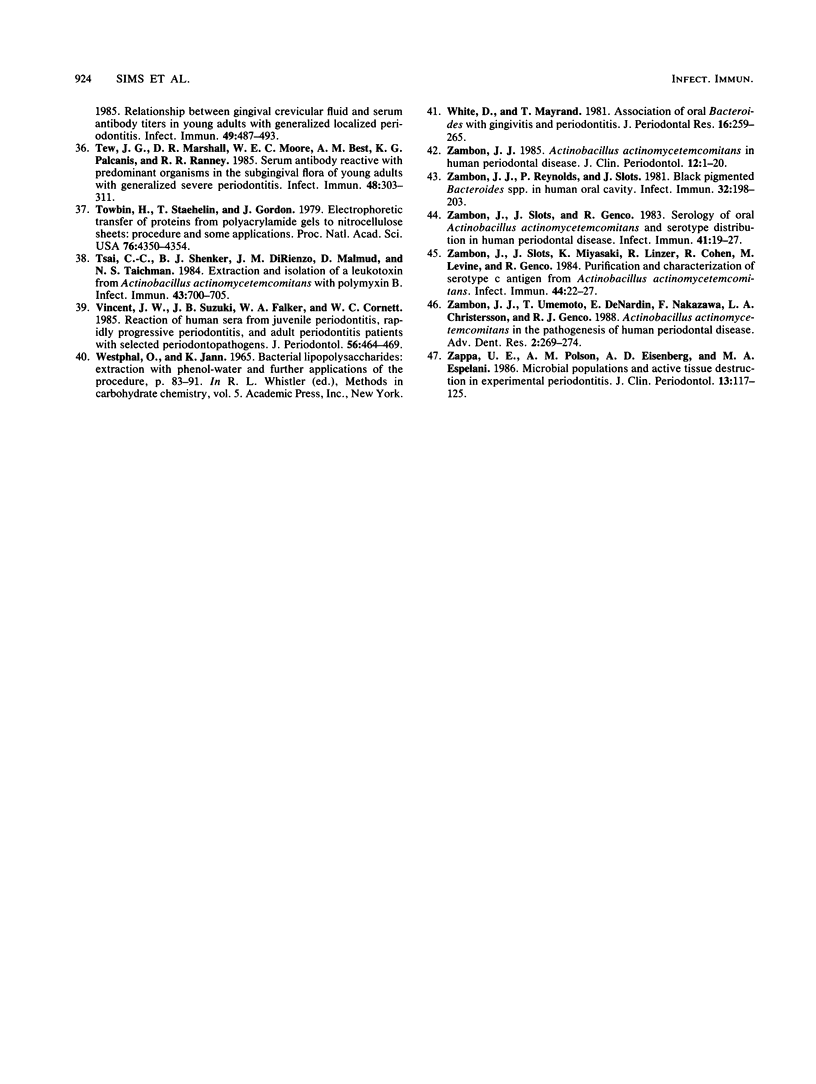
Images in this article
Selected References
These references are in PubMed. This may not be the complete list of references from this article.
- Amano K., Nishihara T., Shibuya N., Noguchi T., Koga T. Immunochemical and structural characterization of a serotype-specific polysaccharide antigen from Actinobacillus actinomycetemcomitans Y4 (serotype b). Infect Immun. 1989 Oct;57(10):2942–2946. doi: 10.1128/iai.57.10.2942-2946.1989. [DOI] [PMC free article] [PubMed] [Google Scholar]
- Califano J. V., Schenkein H. A., Tew J. G. Immunodominant antigen of Actinobacillus actinomycetemcomitans Y4 in high-responder patients. Infect Immun. 1989 May;57(5):1582–1589. doi: 10.1128/iai.57.5.1582-1589.1989. [DOI] [PMC free article] [PubMed] [Google Scholar]
- Caulfield M. J., Shaffer D. A computer program for the evaluation of ELISA data obtained using an automated microtiter plate absorbance reader. J Immunol Methods. 1984 Nov 30;74(2):205–215. doi: 10.1016/0022-1759(84)90288-6. [DOI] [PubMed] [Google Scholar]
- Di Rienzo J. M., Spieler E. L. Identification and characterization of the major cell envelope proteins of oral strains of Actinobacillus actinomycetemcomitans. Infect Immun. 1983 Jan;39(1):253–261. doi: 10.1128/iai.39.1.253-261.1983. [DOI] [PMC free article] [PubMed] [Google Scholar]
- Doty S. L., Lopatin D. E., Syed S. A., Smith F. N. Humoral immune response to oral microorganisms in periodontitis. Infect Immun. 1982 Aug;37(2):499–505. doi: 10.1128/iai.37.2.499-505.1982. [DOI] [PMC free article] [PubMed] [Google Scholar]
- Ebersole J. L., Taubman M. A., Smith D. J., Genco R. J., Frey D. E. Human immune responses to oral micro-organisms. I. Association of localized juvenile periodontitis (LJP) with serum antibody responses to Actinobacillus actinomycetemcomitans. Clin Exp Immunol. 1982 Jan;47(1):43–52. [PMC free article] [PubMed] [Google Scholar]
- Ebersole J. L., Taubman M. A., Smith D. J. Gingival crevicular fluid antibody to oral microorganisms. II. Distribution and specificity of local antibody responses. J Periodontal Res. 1985 Jul;20(4):349–356. doi: 10.1111/j.1600-0765.1985.tb00446.x. [DOI] [PubMed] [Google Scholar]
- Ebersole J. L., Taubman M. A., Smith D. J., Hammond B. F., Frey D. E. Human immune responses to oral microorganisms. II. Serum antibody responses to antigens from Actinobacillus actinomycetemcomitans and the correlation with localized juvenile periodontitis. J Clin Immunol. 1983 Oct;3(4):321–331. doi: 10.1007/BF00915793. [DOI] [PubMed] [Google Scholar]
- Farida R., Wilson M., Ivanyi L. Serum IgG antibodies to lipopolysaccharides in various forms of periodontal disease in man. Arch Oral Biol. 1986;31(11):711–715. doi: 10.1016/0003-9969(86)90001-4. [DOI] [PubMed] [Google Scholar]
- Gmür R., Hrodek K., Saxer U. P., Guggenheim B. Double-blind analysis of the relation between adult periodontitis and systemic host response to suspected periodontal pathogens. Infect Immun. 1986 Jun;52(3):768–776. doi: 10.1128/iai.52.3.768-776.1986. [DOI] [PMC free article] [PubMed] [Google Scholar]
- Gunsolley J. C., Burmeister J. A., Tew J. G., Best A. M., Ranney R. R. Relationship of serum antibody to attachment level patterns in young adults with juvenile periodontitis or generalized severe periodontitis. J Periodontol. 1987 May;58(5):314–320. doi: 10.1902/jop.1987.58.5.314. [DOI] [PubMed] [Google Scholar]
- Hitchcock P. J., Brown T. M. Morphological heterogeneity among Salmonella lipopolysaccharide chemotypes in silver-stained polyacrylamide gels. J Bacteriol. 1983 Apr;154(1):269–277. doi: 10.1128/jb.154.1.269-277.1983. [DOI] [PMC free article] [PubMed] [Google Scholar]
- Iino Y., Hopps R. M. The bone-resorbing activities in tissue culture of lipopolysaccharides from the bacteria Actinobacillus actinomycetemcomitans, Bacteroides gingivalis and Capnocytophaga ochracea isolated from human mouths. Arch Oral Biol. 1984;29(1):59–63. doi: 10.1016/0003-9969(84)90043-8. [DOI] [PubMed] [Google Scholar]
- Inouye M., Shaw J., Shen C. The assembly of a structural lipoprotein in the envelope of Escherichia coli. J Biol Chem. 1972 Dec 25;247(24):8154–8159. [PubMed] [Google Scholar]
- Kiley P., Holt S. C. Characterization of the lipopolysaccharide from Actinobacillus actinomycetemcomitans Y4 and N27. Infect Immun. 1980 Dec;30(3):862–873. doi: 10.1128/iai.30.3.862-873.1980. [DOI] [PMC free article] [PubMed] [Google Scholar]
- LOWRY O. H., ROSEBROUGH N. J., FARR A. L., RANDALL R. J. Protein measurement with the Folin phenol reagent. J Biol Chem. 1951 Nov;193(1):265–275. [PubMed] [Google Scholar]
- Laemmli U. K. Cleavage of structural proteins during the assembly of the head of bacteriophage T4. Nature. 1970 Aug 15;227(5259):680–685. doi: 10.1038/227680a0. [DOI] [PubMed] [Google Scholar]
- Listgarten M. A., Lai C. H., Evian C. I. Comparative antibody titers to Actinobacillus actinomycetemcomitans in juvenile periodontitis, chronic periodontitis and periodontally healthy subjects. J Clin Periodontol. 1981 Jun;8(3):155–164. doi: 10.1111/j.1600-051x.1981.tb02027.x. [DOI] [PubMed] [Google Scholar]
- McArthur W. P., Tsai C. C., Baehni P. C., Genco R. J., Taichman N. S. Leukotoxic effects of Actinobacillus actinomycetemcomitans. Modulation by serum components. J Periodontal Res. 1981 Mar;16(2):159–170. doi: 10.1111/j.1600-0765.1981.tb00962.x. [DOI] [PubMed] [Google Scholar]
- Moore W. E., Holdeman L. V., Cato E. P., Good I. J., Smith E. P., Ranney R. R., Palcanis K. G. Variation in periodontal floras. Infect Immun. 1984 Dec;46(3):720–726. doi: 10.1128/iai.46.3.720-726.1984. [DOI] [PMC free article] [PubMed] [Google Scholar]
- Moore W. E. Microbiology of periodontal disease. J Periodontal Res. 1987 Sep;22(5):335–341. doi: 10.1111/j.1600-0765.1987.tb01595.x. [DOI] [PubMed] [Google Scholar]
- Nishihara T., Fujiwara T., Koga T., Hamada S. Chemical composition and immunobiological properties of lipopolysaccharide and lipid-associated proteoglycan from Actinobacillus actinomycetemcomitans. J Periodontal Res. 1986 Sep;21(5):521–530. doi: 10.1111/j.1600-0765.1986.tb01488.x. [DOI] [PubMed] [Google Scholar]
- Ranney R. R., Yanni N. R., Burmeister J. A., Tew J. G. Relationship between attachment loss and precipitating serum antibody to Actinobacillus actinomycetemcomitans in adolescents and young adults having severe periodontal destruction. J Periodontol. 1982 Jan;53(1):1–7. doi: 10.1902/jop.1982.53.1.1. [DOI] [PubMed] [Google Scholar]
- Sims T. J., Moncla B. J., Page R. C. Serum antibody response to antigens of oral gram-negative bacteria by cats with plasma cell gingivitis-pharyngitis. J Dent Res. 1990 Mar;69(3):877–882. doi: 10.1177/00220345900690031001. [DOI] [PubMed] [Google Scholar]
- Slots J., Genco R. J. Black-pigmented Bacteroides species, Capnocytophaga species, and Actinobacillus actinomycetemcomitans in human periodontal disease: virulence factors in colonization, survival, and tissue destruction. J Dent Res. 1984 Mar;63(3):412–421. doi: 10.1177/00220345840630031101. [DOI] [PubMed] [Google Scholar]
- Slots J., Reynolds H. S., Genco R. J. Actinobacillus actinomycetemcomitans in human periodontal disease: a cross-sectional microbiological investigation. Infect Immun. 1980 Sep;29(3):1013–1020. doi: 10.1128/iai.29.3.1013-1020.1980. [DOI] [PMC free article] [PubMed] [Google Scholar]
- Slots J., Zambon J. J., Rosling B. G., Reynolds H. S., Christersson L. A., Genco R. J. Actinobacillus actinomycetemcomitans in human periodontal disease. Association, serology, leukotoxicity, and treatment. J Periodontal Res. 1982 Sep;17(5):447–448. doi: 10.1111/j.1600-0765.1982.tb02022.x. [DOI] [PubMed] [Google Scholar]
- Smith D. J., Gadalla L. M., Ebersole J. L., Taubman M. A. Gingival crevicular fluid antibody to oral microorganisms. III. Association of gingival homogenate and gingival crevicular fluid antibody levels. J Periodontal Res. 1985 Jul;20(4):357–367. doi: 10.1111/j.1600-0765.1985.tb00447.x. [DOI] [PubMed] [Google Scholar]
- Socransky S. S. Microbiology of periodontal disease -- present status and future considerations. J Periodontol. 1977 Sep;48(9):497–504. doi: 10.1902/jop.1977.48.9.497. [DOI] [PubMed] [Google Scholar]
- Syed S. A. Characteristics of Bacteroides asaccharolyticus from dental plaques of beagle dogs. J Clin Microbiol. 1980 May;11(5):522–526. doi: 10.1128/jcm.11.5.522-526.1980. [DOI] [PMC free article] [PubMed] [Google Scholar]
- Tanner A. C., Haffer C., Bratthall G. T., Visconti R. A., Socransky S. S. A study of the bacteria associated with advancing periodontitis in man. J Clin Periodontol. 1979 Oct;6(5):278–307. doi: 10.1111/j.1600-051x.1979.tb01931.x. [DOI] [PubMed] [Google Scholar]
- Tew J. G., Marshall D. R., Moore W. E., Best A. M., Palcanis K. G., Ranney R. R. Serum antibody reactive with predominant organisms in the subgingival flora of young adults with generalized severe periodontitis. Infect Immun. 1985 May;48(2):303–311. doi: 10.1128/iai.48.2.303-311.1985. [DOI] [PMC free article] [PubMed] [Google Scholar]
- Towbin H., Staehelin T., Gordon J. Electrophoretic transfer of proteins from polyacrylamide gels to nitrocellulose sheets: procedure and some applications. Proc Natl Acad Sci U S A. 1979 Sep;76(9):4350–4354. doi: 10.1073/pnas.76.9.4350. [DOI] [PMC free article] [PubMed] [Google Scholar]
- Tsai C. C., Shenker B. J., DiRienzo J. M., Malamud D., Taichman N. S. Extraction and isolation of a leukotoxin from Actinobacillus actinomycetemcomitans with polymyxin B. Infect Immun. 1984 Feb;43(2):700–705. doi: 10.1128/iai.43.2.700-705.1984. [DOI] [PMC free article] [PubMed] [Google Scholar]
- Vincent J. W., Suzuki J. B., Falkler W. A., Jr, Cornett W. C. Reaction of human sera from juvenile periodontitis, rapidly progressive periodontitis, and adult periodontitis patients with selected periodontopathogens. J Periodontol. 1985 Aug;56(8):464–469. doi: 10.1902/jop.1985.56.8.464. [DOI] [PubMed] [Google Scholar]
- White D., Mayrand D. Association of oral Bacteroides with gingivitis and adult periodontitis. J Periodontal Res. 1981 May;16(3):259–265. doi: 10.1111/j.1600-0765.1981.tb00974.x. [DOI] [PubMed] [Google Scholar]
- Zambon J. J. Actinobacillus actinomycetemcomitans in human periodontal disease. J Clin Periodontol. 1985 Jan;12(1):1–20. doi: 10.1111/j.1600-051x.1985.tb01348.x. [DOI] [PubMed] [Google Scholar]
- Zambon J. J., Reynolds H. S., Slots J. Black-pigmented Bacteroides spp. in the human oral cavity. Infect Immun. 1981 Apr;32(1):198–203. doi: 10.1128/iai.32.1.198-203.1981. [DOI] [PMC free article] [PubMed] [Google Scholar]
- Zambon J. J., Slots J., Genco R. J. Serology of oral Actinobacillus actinomycetemcomitans and serotype distribution in human periodontal disease. Infect Immun. 1983 Jul;41(1):19–27. doi: 10.1128/iai.41.1.19-27.1983. [DOI] [PMC free article] [PubMed] [Google Scholar]
- Zambon J. J., Slots J., Miyasaki K., Linzer R., Cohen R., Levine M., Genco R. J. Purification and characterization of the serotype c antigen from Actinobacillus actinomycetemcomitans. Infect Immun. 1984 Apr;44(1):22–27. doi: 10.1128/iai.44.1.22-27.1984. [DOI] [PMC free article] [PubMed] [Google Scholar]
- Zambon J. J., Umemoto T., De Nardin E., Nakazawa F., Christersson L. A., Genco R. J. Actinobacillus actinomycetemcomitans in the pathogenesis of human periodontal disease. Adv Dent Res. 1988 Nov;2(2):269–274. doi: 10.1177/08959374880020021101. [DOI] [PubMed] [Google Scholar]
- Zappa U. E., Polson A. M., Eisenberg A. D., Espeland M. A. Microbial populations and active tissue destruction in experimental periodontitis. J Clin Periodontol. 1986 Feb;13(2):117–125. doi: 10.1111/j.1600-051x.1986.tb01443.x. [DOI] [PubMed] [Google Scholar]






